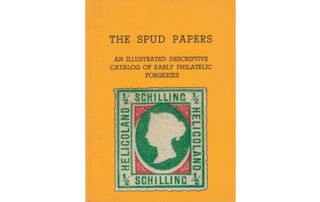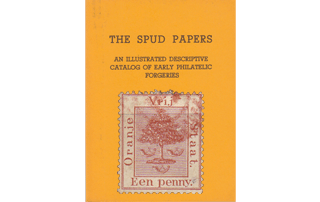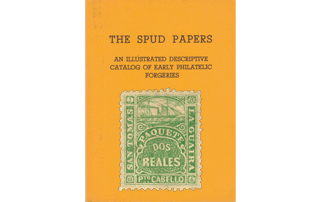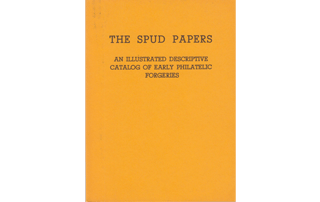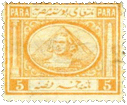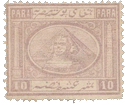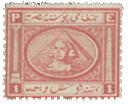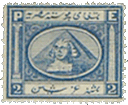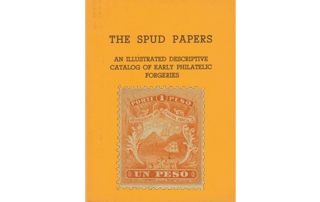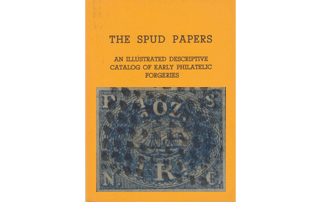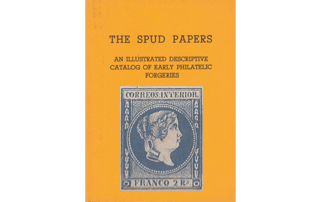The originals of the forgeries that we shall now consider, are usually denominated the 1861 issue, and until recently the correctness of this date has not been seriously questioned. In the September number of the American Journal of Philately a writer who has evidently carefully studied his subject, argues that 1858 is the real date of their appearance, thereby making them the earliest stamps of this state. Although we do not agree with the writer in question, still we consider his opinion worthy of record. He is supported in his views by Bellars and Davie, but we cannot look on those compilers as authorities.
All the genuine are from one matrix, with the lower inscription only varying.
The following are the only authentic colours:
- 2 i 1/2 centavos, black.
- 5 centavos, pale yellow, buff
-
10 centavos, deep blue, light blue
- 20 centavos, dull vermilion-red
-
1 Peso, rose
In the lowest value the conjunction i is used; and this letter standing for and, has until lately been quite overlooked in all the catalogs.
The stone of the 2 i 1/2 C. was evidently altered to make the pesos; for in very clear copies of the latter, portions of the 2, the dot above the 1, and the upper half of the fraction, with trace of the S of CENTAVOS can be discerned. All of this series have been reprinted, and in the 2 i 1/2 C. and 20 C. the figures have been remade. Dr Magnus gives the following test: “The head of the figure 2 on the 2 i 1/2 C. inclines more to the inner line of the oval frame or band in the original, and more to the outer line in the reprint. On the reprint 20 c. the figure 2 is awry, and its head is bent towards the left.”
We will now describe the counterfeits, all of which were produced from one original drawing, with the lettering below, of course, altered.
1865. “Sobre Porte”. 25 & 50 Centavos.
I have not seen a forgery of the 1 peso, but it is very probable that that value has been imitated, as well as the others. All the values are unlike in design, each one entirely different from the rest; and collectors will do well to remember this, as it will save trouble, and prevent their being imposed upon by falsities.
25 C. Genuine
Lithographed in black, on dull blue paper, wove and rather thick. All the lettering very coarse and clumsy. The frame is broken under the letter N of CENTS. The 2 is not nearly so tall as the 5. The condor is very dark; it has a white patch on the cheek, the eye is plainly visible, and the left wing extends some distance under the R of PORTE. The cannons are thick black smudges, and the wheel on the carriage of the right-hand one is scarcely visible. The horizontal lines of background are very much interrupted, not one of them going right across without a break. The appearance is as though they had not taken up the ink properly. Below TS of CENTS, outside the border, there is a little spot. The words and figures appear to have been printed by types, after the rest of the stamp, but I will not be positive about this.
Forged
Lithographed on paper a little thinner than the genuine. The lettering is very thin, and much more elegant than in the originals. There is no break in the frame. The 2 is as tall as the 5. The condor is not very darkly shaded, there is no white patch on the cheek, no eye, the head and neck are equally shaded all over, there is a broad white collar round the neck where it joins the body, and the left wing is cut short just before it reaches the R of PORTE. The cannons are very lightly shaded, and both wheels are very plain. The horizontal lines of back- ground mostly run across without a break. There is no spot outside the border line. This forgery looks much more genuine than the originals!
50 C. Genuine
I need not spend much time over this stamp. It differs totally from the 25 c., is very boldly drawn, and is enclosed in octagonal frame.
Forged
The artist has made a grand mistake here, and has copied the 50 C. from the design of the 25 C., with only a few minor variations, emanating evidently from his own brain. The octagonal frame is, of course, entirely absent.
1865. 1 Peso, Red.
Genuine
Lithographed on thin, bluish-white wove paper. The top compartment of the shield bears seven horizontal lines of shading. The middle compartment contains a cap of Liberty, very distinct, with the tail tailing over to the left-hand side, and shaded with oblique lines. The lowest compartment, of the shield contains an isthmus, with a ship (or mark to represent one) in each sea, both above and below the isthmus. The bird above the shield is a condor, and it has a ring of feathers at the base of the neck. The neck is rather thin, and swan-like; the eye is very small and round. There is a row of white pearls, of tolerably uniform size and shape, all round the central oval, and none of the pearls are missing. Nine eight-pointed stars or asterisks are outside the pearls, all of them pretty distinct and regular. There is a stop after E and U and COLOMBIA, but none after any of the other parts of the inscription. All the lettering is distinct and easy to read. There are two small, crossed white branches at the bottom of the colored oval band; each branch has seven leaves. The centre tongue of the E of PESO projects so far as to be almost level with the top and bottom strokes of the letter. The white space inside the O of PESO is perfectly square, and the stop after this word is very much nearer to the end of the label than to the O. The postmark is usually a written word, or other obliteration in pen-and-ink; but occasionally the stamp is cancelled with an oval, containing the name of town in large capitals.
Forged
Lithographed on rather thick, white wove paper. The top compartment of the shield is so blotched that only one or two lines can be seen. The thing in the middle compartment is a hopeless-looking blotch, which nobody could fashion into a cap of Liberty. The upper sea of the isthmus in the lowest compartment of the shield has no ship or mark to represent one, and the ship in the lower sea is a large, coarse blot, extending light across the sea. The bird above the shield is of an unknown species; it has no ring of feathers round the base of its neck; the eye is very large, and triangular, and there is a dark line running down the middle of the neck, which is not to be seen in the genuine. The row of pearls is very indistinct round the central oval, and the pearls, are very small, and many of them are missing out of the row. There are nine very blotchy-looking asterisks in the colored oval band, but the points of most of them cannot be counted, and the others vary from five upwards. There is a stop after the E., but no stop after the U, and no stop after COLOMBIA; but there is an abnormal stop below the S of NACIONALES. The E of E. U., &c., is so badly formed that it is like an L; and the U is either like an L also, or like a sort of rectangle, according as it is more or less distinctly printed. The E of DE has no central tongue or projection. At the bottom of the colored oval there are two white blotches, but they are not in the least like the distinct, crossed branches of the genuine. The centre tongue of the E of PESO is ridiculously short and thick, not being anything like level with the top and bottom strokes. The white space inside the o of this word is distinctly oval, and the stop is close to the O. The postmark is the oval formed by four straight parallel lines at top and bottom, and five curved parallel lines each side; the same as on one of the forged Japanese described in the present article.
 2 i 1/2, 5, 10, 20 Centavos, and 1 Peso.
2 i 1/2, 5, 10, 20 Centavos, and 1 Peso.
Genuine
Nine stars in oval; T in ESTADOS has a short head-stroke.
Spandrils not very clearly done. A good glass (which every collector should possess) will show thirteen lines in the upper left-angle, and twelve in the right; below, fifteen on left side, and thirteen on right, O of CORREOS is too large, and is very close to the angle of inner frame; both the horizontal and perpendicular outer-lines of which would, if continued, go through the side and bottom of the letter respectively. The S of CORREOS, and c of the following word, are narrower and more upright than the other letters. The inscribed oval breaks into the frame below, and at the right side; also, less distinctly, but still very apparent, upon the left.
The lowest value inscribed 2 i Centavos, and the highest 1 Peso.
Forgeries
Eight stars in oval band, T of ESTADOS with long headline extending farther upon the right side than on the left. Spandrils with lines wide apart and distinct; in lower right angle ten lines, in each of the others, thirteen. The lettering of CORREOS NACIONALES thin and elongated throughout, o of the first-named word does not project beyond the level of either the perpendicular or horizontal lines of inner frame. Central inscribed band projects considerably into the outer frame upon the right side and base, but the arc is scarcely visible upon the left.
The highest value is lettered 1 Peso, and the lowest 2 1/2 Centavos.
1871. 1 Centavo, Green.
Genuine
There is a good deal of variety, both in colour and mode of printing, in the stamps of this issue. The earliest impressions are very well executed, in dark olive-green, somewhat dull and chalky; and the smallest details of the design are brought out clearly. In the later impressions the colour is paler, the green having a slightly yellowish tint, and very dull and chalky. The stamps are on white wove paper, very similar to that of our own newspaper wrappers, but not so soft. The cap of liberty in the fess in the centre of the shield is on a short pole, which can be seen through the cap. (This is very evident in the earliest impressions.) Beneath the fess is a three-masted vessel, sailing to the left; and at the bottom of the shield is a tiny lighthouse, with an equally tiny boat rowing obliquely past it.
Forged
Lithographed, on poor-looking wove paper. Very dull greyish-green, varying from pale to dark. There is a flaw in the line immediately over the top of the S in nacionales, making a white spot which joins the s to the line. The cap of liberty is very indistinct; and there is not the slightest trace of a pole to support it. The thing intended to represent the sailing-vessel is a mere blotch, resembling a one-horse omnibus more than anything else. Below is a single blotch, instead of the lighthouse and boat. Postmarked with parallel bars, forming a circle. Printed in sheets of 25 each.
1872, 2 Centavos, brown.
Genuine
There are two small scrolls across the top containing the motto of the Republic; LIBERTAD in the left-hand scroll, ORDEN in the right. These words can easily be read, and will serve as a good test. In the bottom corners there is a figure 2, with a dot before, after, and beneath it, (• 2 •). The spears bearing the flags are very distinct, and one third of the left-hand flag (the 1/3 nearest the pole) is covered with little dots. These dots signify in heraldry, that the part covered with them is to be gold.
Forged
RTAD in left top corner totally unreadable. ORDEN in right top corner becomes ORGIA. NO dot after 2 in the left bottom corner, and none either before, or after in right. The inscription reads EF. UU, instead of EE. UU. Staff of spear formed of a single line instead of two, and the part of left-hand flag nearest to pole is left quite white. Postmarked with rough blotches, forming a rude rectangle the size of the stamp. Printed in sheets of 25 each.
1870 , 2 1/2 Centavos, Reddish Violet.
Genuine
This stamp is very clearly printed in black, on coloured paper. The figure 2 in 2 1/2 has a solid top with dot in center. The solid label bearing the inscription is divided into three parts by faint lines, one of which is under the CO of CORREOS, another under S of NALES, and the third under the S of CENTS. Both limbs of the UU are of equal thickness.
Forged
Lithographed, and most dreadfully smudged. Much darker in colour than the genuine. No line under CO of CORREOS, and the other two lines only just distinguishable. The 2 of has a curled head. In the UU, the right-hand limbs are hair strokes. Postmarked with an enormous O inscribed with BOGOTA in large thick capitals. None of these stamps are gummed, though of course this is not a crucial test, because this defect could be supplied in an instant by anyone. The reader will notice that we have not attempted to describe the whole of the design, but simply those parts which differ in the originals and the forgeries.
From “The Spud Papers” by Atless, Pemberton & Earée, 1871-1881.
 1/2 Schilling.
1/2 Schilling. 1 Schilling.
1 Schilling. 2 Schilling.
2 Schilling. 6 Schilling.
6 Schilling.
